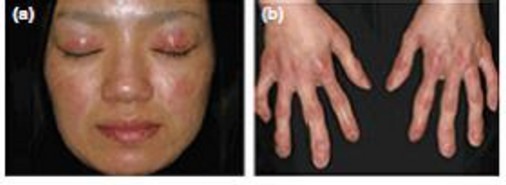(Secondary hypertrophic osteoperiostosis with pernio, amyotrophy-fat tissue anomaly syndrome)
Prevalence < 1.106. Autosomal recessive transmission of a mutation of the PSM8B gene (6p21.3) coding for immunoproteasomes β5 sub-unit. This autoinflammatory disease belongs to the group of the functional anomalies of the proteasomes (ubiquitous intracellular organelles responsible for the degradation and the recycling of proteins).
Clinical features:
- pernio lesions (inflammatory edema of the extremities after exposure to cold) that appear as soon as the first winter of the child' life
- recurrent fever
- circular erythematous nodular eruptions on the face and upper limbs
- lipodystrophy localized to the face and upper limbs resulting in a thin and angular face
- interphalangeal joint contractures: the fingers are very long with clubbing

Sometimes: short stature, hyperhydrosis of the hands and feet, central obesity, myositis
Treatment: corticosteroids, dapsone, tocilizumab
Anesthetic implications:
side effects of the treatment, avoid exposure to cold
References :
- McDermott A, Jacks J, Kessler M, Emanuel PD, Gao L.
Proteasome-associated autoinflammatory syndromes : advances in pathogeneses, clinical presentations, diagnosis, and management.
Int J Dermatology 2014 ; 54 : 121-9
Updated: November 2018